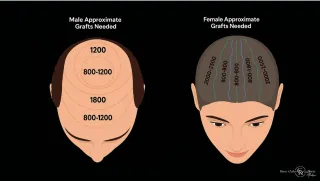Got Questions? We’ve Got Answers
What is a hair transplant, and how does it work?
A hair transplant is a minimally-invasive procedure in which healthy hair follicles are harvested from a donor area (usually the back or sides of the scalp) and transplanted into areas of thinning or baldness. At ROG Hair Institute, we use microsurgical techniques to ensure each graft is placed at the correct angle and depth, allowing it to take root and grow naturally over time.
Which surgical techniques do you offer (e.g., FUE vs. FUT), and how do they differ?
We primarily perform Follicular Unit Extraction (FUE), which involves harvesting individual follicular units one at a time, leaving minimal scarring and a quicker recovery. In contrast, Follicular Unit Transplantation (FUT) involves removing a strip of scalp and dissecting it into grafts; we still discuss FUT candidacy if a patient requires a very large session but most prefer FUE for its reduced downtime and aesthetic benefits.
What makes ROG Hair Institute’s approach unique?
Our signature approach combines precision FUE harvesting with advanced regenerative adjuncts—specifically PDGF growth factors and exosome therapies—to enhance graft survival, accelerate healing, and optimize long-term density. We also tailor each plan based on individual hair characteristics, lifestyle, and goals, rather than offering a one-size-fits-all protocol. PDGF accelerates wound healing and angiogenesis. By injecting PDGF into the transplant site, we create a more robust microenvironment for grafts to take, which can translate into improved initial survival rates and faster early growth.
Exosomes are nanosized signaling vesicles that carry growth factors, cytokines, and microRNAs. When administered around the grafts, they modulate inflammation, stimulate stem cells, and enhance vascularization—resulting in healthier graft uptake and quicker recovery.We inject a customized blend of PDGF growth factors and exosomes into the transplant site at the time of surgery (and at particular intervals post op). These biologics encourage angiogenesis, improve graft uptake, and reduce postoperative inflammation to promote faster, healthier outcomes.
How many grafts are typically needed for a full transplant, and how is that number determined?
Graft requirements vary based on the extent of hair loss, hair caliber, donor density, and patient goals. On average, a moderate session ranges from 1,500 to 3,500 grafts.
During your consultation, we perform a detailed scalp analysis—measuring donor supply and recipient area size—to give you a personalized graft estimate.

Am I a good candidate for a hair transplant?
Ideal candidates are adults with sufficient donor hair density, realistic expectations, and no active scalp infections. We evaluate your medical history, pattern of hair loss, and donor supply to determine if transplantation—or a combination of non-surgical therapies and transplantation—is the best path forward.
What medical or lifestyle factors might disqualify me (e.g., certain scalp conditions, medications, or age)?
Active scalp infections (e.g., severe seborrheic dermatitis), uncontrolled bleeding disorders, or unrealistic expectations can be contraindications. Some medications (e.g., high-dose anticoagulants) may need adjustment before surgery.
Do I need to stop taking medications (e.g., blood thinners) before surgery?
Yes. If you are on anticoagulants (e.g., warfarin, DOACs, aspirin above 81 mg), we typically ask you to stop them under the guidance of your prescribing physician at least 7–10 days before surgery. Any other medications or supplements that increase bleeding risk (e.g., fish oil, vitamin E) should also be paused per our pre-op instructions.
How soon will I start to see new hair growth, and when are final results expected?
Initial shedding of transplanted hairs (shock loss) typically occurs 2–4 weeks after surgery. You’ll notice new “peach fuzz” around 3–4 months, with more substantial growth by 6 months. Final density and texture generally manifest between months 10 and 12.
What is “shock loss,” and how long does it last?
Shock loss refers to temporary shedding of existing hairs (and sometimes transplanted hairs) due to surgical trauma. It usually happens around 2–4 weeks post-op and lasts 4–8 weeks before normal regrowth resumes. Our regenerative protocols (PDGF and exosomes) help shorten the recovery of shock-loss hairs.
Do grafts transplanted in thinning areas continue to thicken over time?
Yes. Transplanted follicles undergo a growth cycle that includes an initial fine phase (around months 3–6), then progressively thicken as they mature through months 6–12. By one year, most grafts reach their full diameter, offering natural density.
Will I need more than one transplant session to achieve my desired density?
It depends on your desired coverage, donor supply, and degree of hair loss. Many patients achieve their goals in a single session, especially when treated early. If you require very high density or have advanced hair loss, we may plan a second session 12–18 months later to refine contours or fill any remaining thin spots.
How long do transplanted hairs typically last—are results permanent?
Transplanted hairs are harvested from the permanent zone (genetically resistant to dihydrotestosterone, DHT), so they should last for life. However, non-transplanted native hairs may continue to thin. We often recommend concurrent medical therapy (e.g., finasteride ± minoxidil) and periodic regenerative boosters to maintain the health of your existing hair.
Are there any long-term risks associated with hair transplants or regenerative adjuncts?
Long-term risks are minimal. Transplanted grafts remain permanent in most cases. Rarely, overharvesting can lead to donor-area thinning if protocol isn’t followed, but we prevent that through careful planning. Regenerative adjuncts like PDGF and exosomes have excellent safety profiles; allergic reactions are exceedingly rare since they are autologous or allogeneic cell-derived products processed under strict standards.
How much does a hair transplant cost at ROG Hair Institute?
Our pricing structure starts at $3.75 per graft for FUE, with most patients requiring 1,500–3,000 grafts. This means typical total costs range from $7,500 to $15,000. Exact pricing is determined after your consultation and graft estimate. We do not accept health insurance.
Do you offer payment plans, financing options, or CareCredit?
Yes. We partner with leading medical financing companies—CareCredit, Cherry, and After Pay—to provide 0% APR plans up to 24 months, as well as longer-term financing with competitive rates. Our patient coordinators can guide you through the application process to find the best option for your budget.
What is included in the quoted price (e.g., consultations, follow-ups, post-op medications)?
Your quoted price includes:
Pre-operative consultation & scalp analysis
Surgical procedure (FUE graft harvesting and placement)
First 1-week post-op check and one 1-month follow-up appointments
All necessary graft placement tools and consumables
Post-operative kit (1 week of bandages, surgical cap, post-op instructions)
Regenerative injections at the time of surgery (PDGF + exosomes) and again at your 1-month follow up appointment.
Post-op medications (NSAIDs, antibiotics, analgesics) are also covered. Additional boosters at weeks 4 or 12 are available for a nominal fee, which we discuss during your pre-op planning.
Do I need to continue medications (e.g., finasteride, minoxidil) after surgery?
While transplanted follicles are permanent, continuing finasteride or minoxidil can help preserve your existing hair and prevent further thinning. We strongly recommend a tailored medical protocol for at least 12 months post-op, and then ongoing as needed based on your progression.
What ongoing or maintenance treatments do you recommend to protect my existing hair?
In addition to medical therapy, we suggest quarterly regenerative maintenance to revitalize both transplanted and existing hair — either an exosome or PDGF injection — to support scalp health, sustain collagen production, improve vascularity, and extend the anagen phase of hair growth. Recommended intervals are 3, 6 and 12 months post transplant, and then quarterly thereafter. Periodic low-level laser therapy (LLLT) can also improve local blood flow and strengthen follicles, especially in areas at risk of miniaturization.
What tips do you have for sun protection, nutrition, or lifestyle habits to prolong my results?
Wear a loose-fitting hat or use a broad-spectrum SPF 30+ sunscreen on your scalp when outdoors for extended periods. Maintain a balanced diet rich in protein, omega-3 fatty acids, and antioxidants (e.g., leafy greens, berries). Avoid smoking and excessive alcohol, as both can impair circulation and follicle health. Finally, manage stress through regular exercise or mindfulness practices, since chronic stress can exacerbate hair shedding.
How soon can I travel after my hair transplant?
You may travel by car or short domestic flights (under 2 hours) 5 days post-op, provided you have no complications. For longer flights (over 4 hours), we recommend waiting 10–14 days to ensure proper graft adherence and adequate healing of donor sites.
Are there age limits for surgery (e.g., under 25 or over 65)?
While there’s no strict age cutoff, we evaluate under-25 patients carefully, since hair loss patterns may not be fully established. For patients over 65, we assess overall health (e.g., cardiovascular status) and donor supply; many seniors still make excellent candidates if they’re in good health with sufficient donor density.
If I live out of town, do you offer coordination for multiple visits or remote follow-up?
Yes. We coordinate your initial consultation via in-person or a comprehensive telemedicine visit (with high-resolution photos). For out-of-town patients, we can schedule all visits back-to-back to minimize travel (e.g., consultation, surgery, 48-hour post-op check within 3 days). Subsequent follow-ups can be conducted via telemedicine—just send updated photos and a short video so our team can evaluate your progress.
Why travel to Turkey?
When the best in hair transplantation is
right HERE in the USA!
Your Journey to Confidence Starts Here! Thousands of men and women struggle silently with hair loss. At ROG Hair Institute, we’re changing the conversation — with proven solutions, not false promises.
Copyright 2025 @ ROG Hair Institute | All Rights Reserved | Privacy Policy | Terms & Conditions





